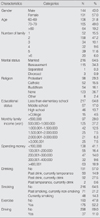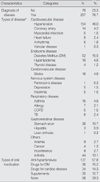Abstract
Purpose
This study aimed to identify the associated factors of the perceived health status of the elderly in Korea and to provide basic data for developing nursing interventions for the elderly's health management.
Methods
This study used a descriptive correlational research design. The subjects of this study were 335 elderly people over 60 yr living in an urban city. Data were collected through personal interviews using questionnaires from September 2006 to March 2007. Empirical indicators of perceived health status were measured by SF-36, nutritional screening initiative (NSI), activities of daily living (ADL) Index, and instrumental activities of daily living (IADL) scale. The collected data were analyzed by descriptive statistics, Pearson's correlation, and hierarchical regression.
Results
The mean age of the subjects was 72.8 and 57.0% of subjects were female. 41.5% of variance in physical health was explained by nutrition, ADL, IADL, and the number of years attending school. Among them the most important factor was ADL. 13.2% of variance in mental health was explained by the number of family, nutrition, and IADL. Among them the most important factor was nutrition.
Figures and Tables
References
1. Bobak M, Pikhart H, Hertzman C, Rose R, Marmot M. Socioeconomic factors perceived control and self-reported health in Russia. A cross-sectional survey. Soc Sci Med. 1998. 47:269–279.

2. Choi EJ. Social relationship, social support and mental and physical health for old adults. Society Culture. 2000. 11:185–203.
3. Choi YJ, Park YS, Kim C, Chang YK. Evaluation of functional ability and nutritional risk according to Self-Rated Health (SRH) of the elderly in Seoul and Kyunggi-do. Korean Nutr Soc. 2004. 37:223–235.
4. Gong SJ, Kim HS, Ha MO. The predictors of subjective well-being among older adults. J Korean Acad Adult Nurs. 2005. 17:368–378.
5. Han AK. A study on physiological parameter, physical health status, and health perception in the elderly. J Korean Acad Adult Nurs. 2004. 16:460–469.
6. Han KH. Nutritional and health status of the elderly male and female in chong-ju area. J Appl Sci Technol. 2000. 6(1):307–329.
7. Jang EH, Kim HJ, Kwon KN, Chung KA, Kim YH, Lee IH. A survey on physical health status and health behavior of the elderly who live alone and who live with family. Yeungnam College Science Technology. 2003. 33:91–104.
8. Jung YM, Kim JH. Comparison of cognitive levels nutritional status, depression in the elderly according to living situations. J Korean Acad Nurs. 2004. 34:495–503.

9. Kanagae M, Abe Y, Honda S, Takamura N, Kusano Y, Takemoto T, et al. Determinants of self-rated health among community-dwelling women aged 40 years and over in Japan. Tohuku J Exp Med. 2006. 210(1):11–19.

10. Keller HH. Nutrition and health-related quality of life in frail older adults. J Nutr Health Aging. 2004. 8:245–252.
11. Kennedy-Malone L, Fletcher KR, Plank LM. Management guidelines for nurse practitioners working with older adults. 2004. 2nd ed. Philadelphia: F.A. Davis Company.
12. Kim CG. The relationship of family support, health perception, nutritional status and depression in elders. J Korean Gerontol Nurs. 2007. 9(1):14–21.
13. Kim YS. Health state variation and health management of old men. 2003. Pusan: Kosin University;Unpublished master's thesis.
14. Kim CG, Jang HJ, Kim SS. The correlation between ability of activity in daily living and self-care agency among elderly in chunchon province. J Korean Acad Adult Nurs. 2001. 13(1):40–52.
15. Korean standard industrial classification. Korea National Statistical Office. 2006. Retrieved from http://www.nso.go.kr.
16. Lawton MP, Brody EM. Assessment of older people: Self-maintaining and instrumental activities of daily living. Gerontologist. 1969. 9:179–186.

17. Lee SY, Choi SJ, Na YH. A study on the healthrelated quality of life. Korean J Gastrointestinal Mortality. 2001. 7(1):6–17.
18. Lee KJ, Park HS. A study on the perceived health status, depression, and activities of daily living for elderly in urban areas. Korean J Women Health Nurs. 2006. 12:221–230.
19. Mahoney FJ, Barthel DW. Functional evaluation: The barthel index. Md State Med J. 1965. 14(1):1–3.
20. The World Health Report. Ministry of Health & Welfare. 2007. Retrieved Nov. 6, 2007. from http://www.nso.go.kr.
21. Society at a glance-OECD social indicators. Ministry of Health & Welfare. 2006. Retrieved Aug. 31, 2007. from http://www.nso.go.kr.
22. Phillips LJ, Hammock RL, Blanton JM. Predictors of self-rated health status among Texas residents. Prev Chronic Dis. 2005. 2(4):1–10.
23. Ro YJ, Kim CG. Comparisons of physical fitness, self efficacy, instrumental activities of daily living, and quality of life between institutionalized and noninstitutionalized elderly. J Korean Acad Nurs. 1995. 25:259–278.

24. Shah S, Vanclay F, Cooper B. Improving the sensitivity of the barthel Index for stroke rehabilitation. J Clin Epidemiol. 1989. 42:703–709.

25. Smith AM, Shelley JM, Dennerstein L. Self-rated health: biological continuum or social discontinuity? Soc Sci Med. 1994. 39(1):77–83.

26. Song KC, Kim DK. Activities of daily living of elderly in a rural area and study for related factors. J Korean Geriatr Soc. 2002. 6(1):29–40.
27. Sung JA. A study on the cognitive function and quality of life in the elderly people living at home. 2007. Seoul: Ewha Womans University;Unpublished doctoral dissertation.
28. Ware JE. Scales for measuring general health perceptions. Health Serv Res. 1976. 11:396–415.
29. Ware JE, Sherbourne CD. The MOS 36-item short-form health survey (SF-36). I. Conceptual framework and item selection. Med Care. 1992. 30:473–483.




 PDF
PDF ePub
ePub Citation
Citation Print
Print








 XML Download
XML Download